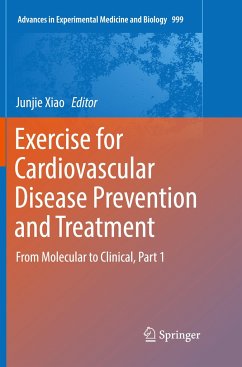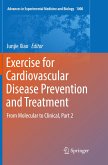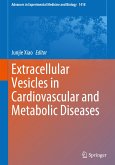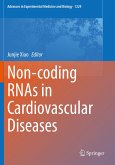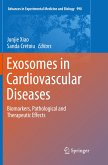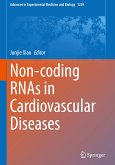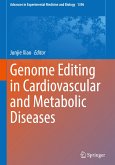Exercise for Cardiovascular Disease Prevention and Treatment
From Molecular to Clinical, Part 1
Herausgegeben:Xiao, Junjie
Exercise for Cardiovascular Disease Prevention and Treatment
From Molecular to Clinical, Part 1
Herausgegeben:Xiao, Junjie
- Broschiertes Buch
- Merkliste
- Auf die Merkliste
- Bewerten Bewerten
- Teilen
- Produkt teilen
- Produkterinnerung
- Produkterinnerung
The book provides an intensive overview on exercise for cardiovascular disease prevention and treatment, from basic research to clinical practice. The volume firstly summarizes the acute and chronic response to exercise. Secondly, evidence for exercise as medicine for the heart based on clinical studies and basic research is summarized. Thirdly, molecular mechanisms mediating the beneficial effects of exercise including IGF-1-PI3K-AKT signalling, NO signalling, C/EBPB-Cited4 signalling, Non-coding RNAs, epigenetic regulators, mitochondria adaption and exosomes are presented. Finally, exercise…mehr
Andere Kunden interessierten sich auch für
![Exercise for Cardiovascular Disease Prevention and Treatment Exercise for Cardiovascular Disease Prevention and Treatment]() Exercise for Cardiovascular Disease Prevention and Treatment134,99 €
Exercise for Cardiovascular Disease Prevention and Treatment134,99 €![Extracellular Vesicles in Cardiovascular and Metabolic Diseases Extracellular Vesicles in Cardiovascular and Metabolic Diseases]() Extracellular Vesicles in Cardiovascular and Metabolic Diseases112,99 €
Extracellular Vesicles in Cardiovascular and Metabolic Diseases112,99 €![Extracellular Vesicles in Cardiovascular and Metabolic Diseases Extracellular Vesicles in Cardiovascular and Metabolic Diseases]() Extracellular Vesicles in Cardiovascular and Metabolic Diseases112,99 €
Extracellular Vesicles in Cardiovascular and Metabolic Diseases112,99 €![Non-coding RNAs in Cardiovascular Diseases Non-coding RNAs in Cardiovascular Diseases]() Non-coding RNAs in Cardiovascular Diseases112,99 €
Non-coding RNAs in Cardiovascular Diseases112,99 €![Exosomes in Cardiovascular Diseases Exosomes in Cardiovascular Diseases]() Exosomes in Cardiovascular Diseases82,99 €
Exosomes in Cardiovascular Diseases82,99 €![Non-coding RNAs in Cardiovascular Diseases Non-coding RNAs in Cardiovascular Diseases]() Non-coding RNAs in Cardiovascular Diseases113,99 €
Non-coding RNAs in Cardiovascular Diseases113,99 €![Genome Editing in Cardiovascular and Metabolic Diseases Genome Editing in Cardiovascular and Metabolic Diseases]() Genome Editing in Cardiovascular and Metabolic Diseases119,99 €
Genome Editing in Cardiovascular and Metabolic Diseases119,99 €-
-
-
The book provides an intensive overview on exercise for cardiovascular disease prevention and treatment, from basic research to clinical practice. The volume firstly summarizes the acute and chronic response to exercise. Secondly, evidence for exercise as medicine for the heart based on clinical studies and basic research is summarized. Thirdly, molecular mechanisms mediating the beneficial effects of exercise including IGF-1-PI3K-AKT signalling, NO signalling, C/EBPB-Cited4 signalling, Non-coding RNAs, epigenetic regulators, mitochondria adaption and exosomes are presented. Finally, exercise dosing, prescription and future prospects are provided. This book will provide valuable reference for researchers in cell biology, physiology, as well as physician, physical therapist in cardiology, sport medicine, etc.
Produktdetails
- Produktdetails
- Advances in Experimental Medicine and Biology 999
- Verlag: Springer / Springer Nature Singapore / Springer, Berlin
- Artikelnr. des Verlages: 978-981-13-5101-3
- Softcover reprint of the original 1st ed. 2017
- Seitenzahl: 332
- Erscheinungstermin: 13. Dezember 2018
- Englisch
- Abmessung: 235mm x 155mm x 17mm
- Gewicht: 614g
- ISBN-13: 9789811351013
- ISBN-10: 9811351015
- Artikelnr.: 54800402
- Herstellerkennzeichnung
- Springer-Verlag GmbH
- Tiergartenstr. 17
- 69121 Heidelberg
- ProductSafety@springernature.com
- Advances in Experimental Medicine and Biology 999
- Verlag: Springer / Springer Nature Singapore / Springer, Berlin
- Artikelnr. des Verlages: 978-981-13-5101-3
- Softcover reprint of the original 1st ed. 2017
- Seitenzahl: 332
- Erscheinungstermin: 13. Dezember 2018
- Englisch
- Abmessung: 235mm x 155mm x 17mm
- Gewicht: 614g
- ISBN-13: 9789811351013
- ISBN-10: 9811351015
- Artikelnr.: 54800402
- Herstellerkennzeichnung
- Springer-Verlag GmbH
- Tiergartenstr. 17
- 69121 Heidelberg
- ProductSafety@springernature.com
Dr. Junjie Xiao is Principal Investigator and Associate Professor at Regeneration and Ageing Lab in Shanghai University, Shanghai, China.
Part I: Overview.- Chapter 1: Physical inactivity and the economic and health burdens due to cardiovascular disease: exercise as medicine (Mark Hamer).- Part II: Cardiac Exercise Physiology.- Chapter 2: Acute and chronic response to exercise in athletes: the "Supernormal Heart (Antonello D'Andrea).- Chapter 3: The effects of exercise on cardiovascular biomarkers: new insights, recent data, and applications (Lin Che).- Chapter 4: Acute and chronic exercise in animal models (Vu Thi Thu).- Part III: Cardiac Cells Adaptations in Exercise.- Chapter 5 Structural, contractile and electrophysiological adaptations of cardiomyocytes to chronic exercise (Krzesiak A).- Chapter 6: Formation of new cardiomyocytes in exercise (Liang Shen).- Chapter 7: Physical exercise can spur beneficial neoangiogenesis and microvasculature remodeling within the heart - our salvation? (Michal Miko).- Chapter 8 The non-cardiomyocyte cells of heart. their possible roles in exercise-based cardiac regeneration, reparation and remodeling (Ivan Varga).- Part IV: Exercise benefits the Heart: Basic Science Evidence.- Chapter 9: Myocardial infarction and exercise training: evidence from basic science (Ivana Cinthya Moraes-Silva).- Chapter 10: Cardiac ischemia/reperfusion injury (Juliana Pereira Borges).- Chapter 11: Experimental evidences supporting the benefits of exercise training in heart failure (Marcelo H. A. Ichige).- Chapter 12: Exercise amaliorates metabolic disturbances and oxidative stress in diabetic cardiomyopathy: possible underlying mechanisms (Ayman M. Mahmoud).- Chapter 13: Cardiac aging - benefits of exercise, Nrf2 activation and antioxidant signaling (Madhusudhanan Narasimhan).- Chapter 14: Cardiac fibrosis:the beneficial effects of exercise in cardiac fibrosis (Jan Kyselovic).- Chapter 15: Physical exercise is a potential "medicine" for atherosclerosis (Jian Yang).- Chapter 16: Experimental evidences supporting training-induced benefits in spontaneously hypertensive rats (GustavoS. Masson).- Chapter 17: Exercise training in pulmonary hypertension and right heart failure: insights from pre-clinical studies (Daniel Moreira-Gonçalves).- Part V: Exercise benefits the Heart: Clinical Evidence.- Chapter 18: Coronary heart disease (Lei Wang).- Chapter 19: Exercise exerts its beneficial effects on acute coronary syndrome clinical evidence (Zhuyuan Liu).- Chapter 20: Exercise-based rehabilitation for heart failure:clinical evidence (Rongjing Ding).- Chapter 21: The benefits of exercise training on aerobic capacity in patients with Heart Failure and Preserved Ejection Fraction (Danilo Marcelo Leite do Prado).- Chapter 22: Hypertension and exercise training: evidence from clinical studies (Ivana Cinthya Moraes-Silva).- Chapter 23: Effects of exercise on arrhythmia (and viceversa): lesson from the Greek mythology (Caterina Lambiase).- Chapter 24: Exercise and congenital heart disease (Junnan Wang).- Chapter 25: The Positive Effects of Exercise in Chemotherapy-related Cardiomyopathy (Cavarretta Elena).- Chapter 26: Clinical evidence of exercise benefits for stroke (Peipei Han).- Chapter 27: Pulmonary hypertension (Abraham Samuel Babu).- Chapter 28: Peripheral vascular disease (Basant Elnady).- Part VI: Molecular Mechanisms.- Chapter 29 Molecular mechanisms (Kate L. Weeks).- Chapter 30: NO Signaling in the cardiovascular system and exercise (Tiago Fernandes).- Chapter 31: C/EBPB-CITED4 in exercised heart (Shengguang Ding).- Chapter 32: MicroRNAs mediate beneficial effects of exercise in heart (Yihua Bei).- Chapter 33: Exercise training and epigenetic regulation: multilevel modification and regulation of gene expression (Ursula Paula Renó Soci).- Chapter 34: Exercise-induced mitochondrial adaptations in addressing heart failure (Jubert Marquez).- Chapter 35: Exosomes mediate the beneficial effects of exercise (Yangxin Li).- Part VII: Exercise Dosing and Prescription.- Chapter 36: Exercise dosing and prescription-Playing it safe: dangers and prescription(Lei Wang).
Part I: Overview.- Chapter 1: Physical inactivity and the economic and health burdens due to cardiovascular disease: exercise as medicine (Mark Hamer).- Part II: Cardiac Exercise Physiology.- Chapter 2: Acute and chronic response to exercise in athletes: the "Supernormal Heart (Antonello D'Andrea).- Chapter 3: The effects of exercise on cardiovascular biomarkers: new insights, recent data, and applications (Lin Che).- Chapter 4: Acute and chronic exercise in animal models (Vu Thi Thu).- Part III: Cardiac Cells Adaptations in Exercise.- Chapter 5 Structural, contractile and electrophysiological adaptations of cardiomyocytes to chronic exercise (Krzesiak A).- Chapter 6: Formation of new cardiomyocytes in exercise (Liang Shen).- Chapter 7: Physical exercise can spur beneficial neoangiogenesis and microvasculature remodeling within the heart - our salvation? (Michal Miko).- Chapter 8 The non-cardiomyocyte cells of heart. their possible roles in exercise-based cardiac regeneration, reparation and remodeling (Ivan Varga).- Part IV: Exercise benefits the Heart: Basic Science Evidence.- Chapter 9: Myocardial infarction and exercise training: evidence from basic science (Ivana Cinthya Moraes-Silva).- Chapter 10: Cardiac ischemia/reperfusion injury (Juliana Pereira Borges).- Chapter 11: Experimental evidences supporting the benefits of exercise training in heart failure (Marcelo H. A. Ichige).- Chapter 12: Exercise amaliorates metabolic disturbances and oxidative stress in diabetic cardiomyopathy: possible underlying mechanisms (Ayman M. Mahmoud).- Chapter 13: Cardiac aging - benefits of exercise, Nrf2 activation and antioxidant signaling (Madhusudhanan Narasimhan).- Chapter 14: Cardiac fibrosis:the beneficial effects of exercise in cardiac fibrosis (Jan Kyselovic).- Chapter 15: Physical exercise is a potential "medicine" for atherosclerosis (Jian Yang).- Chapter 16: Experimental evidences supporting training-induced benefits in spontaneously hypertensive rats (GustavoS. Masson).- Chapter 17: Exercise training in pulmonary hypertension and right heart failure: insights from pre-clinical studies (Daniel Moreira-Gonçalves).- Part V: Exercise benefits the Heart: Clinical Evidence.- Chapter 18: Coronary heart disease (Lei Wang).- Chapter 19: Exercise exerts its beneficial effects on acute coronary syndrome clinical evidence (Zhuyuan Liu).- Chapter 20: Exercise-based rehabilitation for heart failure:clinical evidence (Rongjing Ding).- Chapter 21: The benefits of exercise training on aerobic capacity in patients with Heart Failure and Preserved Ejection Fraction (Danilo Marcelo Leite do Prado).- Chapter 22: Hypertension and exercise training: evidence from clinical studies (Ivana Cinthya Moraes-Silva).- Chapter 23: Effects of exercise on arrhythmia (and viceversa): lesson from the Greek mythology (Caterina Lambiase).- Chapter 24: Exercise and congenital heart disease (Junnan Wang).- Chapter 25: The Positive Effects of Exercise in Chemotherapy-related Cardiomyopathy (Cavarretta Elena).- Chapter 26: Clinical evidence of exercise benefits for stroke (Peipei Han).- Chapter 27: Pulmonary hypertension (Abraham Samuel Babu).- Chapter 28: Peripheral vascular disease (Basant Elnady).- Part VI: Molecular Mechanisms.- Chapter 29 Molecular mechanisms (Kate L. Weeks).- Chapter 30: NO Signaling in the cardiovascular system and exercise (Tiago Fernandes).- Chapter 31: C/EBPB-CITED4 in exercised heart (Shengguang Ding).- Chapter 32: MicroRNAs mediate beneficial effects of exercise in heart (Yihua Bei).- Chapter 33: Exercise training and epigenetic regulation: multilevel modification and regulation of gene expression (Ursula Paula Renó Soci).- Chapter 34: Exercise-induced mitochondrial adaptations in addressing heart failure (Jubert Marquez).- Chapter 35: Exosomes mediate the beneficial effects of exercise (Yangxin Li).- Part VII: Exercise Dosing and Prescription.- Chapter 36: Exercise dosing and prescription-Playing it safe: dangers and prescription(Lei Wang).

